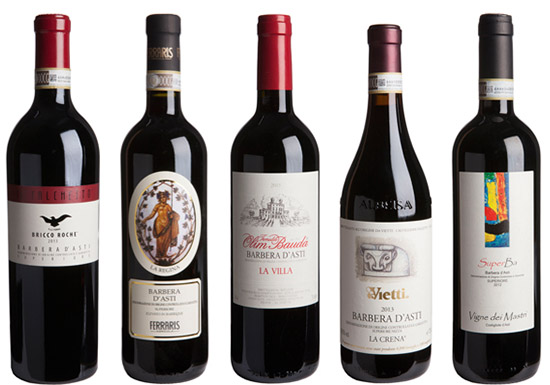Our panel tasting experts have picked their top wines from outside the vaunted vineyards of Barolo and Barbaresco. Expect to see Langhe Nebbiolo and Nebbiolo d'Alba wines that are fruity, approachable and versatile when it comes to food matching. And many are under £25...
Decanter’s experts tasted Piedmont Nebbiolo for the July 2017 issue of Decanter magazine.
Admirers of northwest Italy’s mercurial reds can find plenty of early enjoyment in the wines of DOCs Langhe Nebbiolo and Nebbiolo d’Alba. Nebbiolo is synonymous with two of Piedmont’s most famous and finest wines, but what’s happening beyond Barolo and Barbaresco?
‘The exciting thing about this tasting is that it shows another side of Nebbiolo and expands its offer,’ declared Michael Garner.
The scores:
72 wines tasted
Exceptional – 0
Outstanding – 0
Highly Recommended – 15
Recommended – 43
Commended – 8
Fair – 4
Poor – 0
Faulty – 2
The judges:
Andrea Briccarello; Michael Garner; Susan Hulme MW
Click here to view the full results of the Piedmont Nebbiolo Panel Tasting
The idea of a Nebbiolo tasting that excludes the two most famous Piedmont DOCGs of Barolo and Barbaresco is timely, since Nebbiolo as a variety has never enjoyed such popularity, and Langhe Nebbiolo and Nebbiolo d’Alba wines are becoming increasingly fashionable.
This is partly because these two DOCs allow producers to make wines that are accessible when much younger, while also being available on the market sooner than Barolo or Barbaresco.
Furthermore, Langhe Nebbiolo and Nebbiolo d’Alba wines are far less expensive and can act as an introduction to the qualities of Nebbiolo, hopefully providing a stepping stone to Barolo or Barbaresco.
Continue reading below
Piedmont Nebbiolo Panel Tasting top scorers:
Click on the wines to see UK and US stockists, where available, and also the full tasting note.
To read Decanter’s full Panel Tasting reports, subscribe to Decanter magazine – available in print and digital.
Within the two DOCs, wine styles can range from light and delicate to robust and firmly structured. Generally, producers are moving away from maturation in small oak barriques and are returning to botti grandi, to allow the purer flavours of Nebbiolo to be expressed.
Langhe Nebbiolo
‘Langhe Nebbiolo wines are usually from grapes planted within the growing areas of Barolo and Barbaresco, often from younger vines and often made in such a way that they do not conform the Barolo and Barbaresco spec, particularly in relation to the ageing’, said Garner.
‘Langhe Nebbiolo wines can really give you a feel for what a Barolo or Barbaresco producer’s house style is all about’, added Briccarello.
Nebbiolo d’Alba
As for Nebbiolo d’Alba, Garner identified it as a strange, more difficult category: ‘It’s in the zone that surrounds Barolo and Barbaresco, and many of the sites are not brilliantly situated. It’s also a denomination with stricter discipline, which doesn’t necessarily play to the strength of Nebbiolo.’
Differing opinions
Unsurprisingly, the panel found some noticeable differences in style within the different denominations, and opinions were not always shared. Garner identifed Langhe Nebbiolo as similar to Barolo and Barbaresco but fresher, fruiter and lighter in style, though with less of the secondary and tertiary characters.
However, Susan Hulme MW was expecting a little more: ‘I find slightly more supressed fruit on some. There were a lot of very good wines but not many outstanding ones. I think there is a slight reluctance to take risks, almost as if they are trying to be Barolos instead of celebrating their own identity in a more vibrant, fruit-driven style.’
The panel found less of the fruity character in the Nebbiolo d’Alba wines. ‘Nebbiolo d’Alba usually spends some time in oak – not as much as Barbaresco or Barolo, but more than Langhe – and I think it suffers for it,’ said Garner. ‘It doesn’t have the complexity and richness of Barolo or Barbaresco, but nor does it have the sort of fresh, frank and fruity aromas that appeal in Langhe Nebbiolo.’ Unfortunately this tasting didn’t feature enough samples from the other Nebbiolo denominations to make a judgement on them, but Briccarello was impressed with the few wines from Gattinara and Roero.
Vintages
The 2015s seem to be the star of the show, Briccarello describing them as ‘approachable and easy to enjoy, with soft tannins and beautiful bramble fruits’. Despite 2014 being a more difficult vintage, Garner was pleasantly surprised: ‘Some were mean, lean and green but there were plenty of drinkable styles to enjoy now.’
Related content:

Top Barbera d’Asti wines – panel tasting results
See what our judges thought about Barbera d'Asti in this panel tasting from the May 2017 issue of Decanter magazine...

Toscana Rosso – the ‘little brothers’ of Tuscany
Second wines from the famous names of Tuscany...

Five delicious Barolo alternatives
Think you need Barolo in your life? Here are five reasons to think again...

Premium red Rioja – panel tasting results
Incredible value for money, said our judges...







